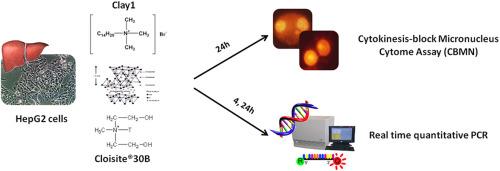Effects of two organomodified clays intended to food contact materials on the genomic instability and gene expression of hepatoma cells |
| |
| Affiliation: | 1. Department of Sanitary Engineering, Faculty of Public Health, Mahidol University, Rajvithee Road, Bangkok 10400, Thailand;2. Department of Global Environmental Health Sciences, Tulane University School of Public Health and Tropical Medicine, New Orleans, LA 70112, USA;3. Center of Excellence on Environmental Health and Toxicology, Bangkok 10400, Thailand |
| |
| Abstract: | 
Globally, food industries have made significant progress in order to increase the shelf-life of food products and have fewer economic losses. In this sense, the use of organomodified clays destined to be incorporated in polymer matrices play a novel role, leading to improved materials named nanocomposites with enhanced technological profiles. Due to the presence of these clays into the package, the safety of the consumers is a main concern. Cloisite®30B and Clay1 are two organomodified clays containing quaternary ammonium salts as modifiers, that can be potentially used to reinforce packaging polymers. Available toxicity data about these clays, specifically genotoxicity, is still limited and inconclusive in some aspects. Thus, the purpose of this work was to evaluate both clays ability to induce genomic instability through the cytokinesis block micronucleus cytome assay (CBMN) and for the first time, their influence in the modulation of several genes involved in genotoxicity and cell death mechanisms. Overall, no genotoxicity response was obtained in any case at the conditions tested. On the other hand, significant expression changes were observed on the genes selected. Nevertheless, further studies are highly needed to elucidate and increase the knowledge about the molecular mechanisms of clays toxicity. |
| |
| Keywords: | Food contact material Organomodified clays Cytokinesis block micronucleus cytome assay Gene expression qPCR |
| 本文献已被 ScienceDirect 等数据库收录! |
|

